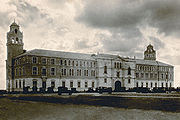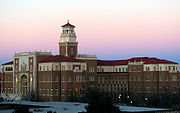
History of Texas Tech University
Encyclopedia

Establishment
The call to open a college in West Texas began shortly after the arrival of settlers in the area in the 1880s. In 1917, the Texas legislature passed a bill creating a branch of Texas A&MTexas A&M University
Texas A&M University is a coeducational public research university located in College Station, Texas . It is the flagship institution of the Texas A&M University System. The sixth-largest university in the United States, A&M's enrollment for Fall 2011 was over 50,000 for the first time in school...
to be located in Abilene
Abilene, Texas
Abilene is a city in Taylor and Jones counties in west central Texas. The population was 117,063 at the 2010 census. It is the principal city of the Abilene Metropolitan Statistical Area, which had a 2006 estimated population of 158,063. It is the county seat of Taylor County...
. However, the bill was repealed two years later during the next session after it was discovered that Governor James E. Ferguson
James E. Ferguson
James Edward "Pa" Ferguson, Jr. , was a Democratic politician from the state of Texas.- Early life :Ferguson was born to the Reverend James Ferguson, Sr., and Fannie Ferguson near Salado in south Bell County, Texas. He entered Salado College at age twelve but was eventually expelled for...
had falsely reported the site committee's choice of location. After new legislation passed in the state house and senate in 1921, Governor Pat Neff
Pat Morris Neff
Pat Morris Neff was the 28th Governor of Texas from 1921 to 1925 and 9th President of Baylor University from 1932 to 1947.-Early life:...
vetoed it, citing hard financial times in West Texas. Furious about Neff's veto, some in West Texas went so far as to recommend that West Texas secede from the state.
In 1923, the legislature decided that, rather than a branch campus, an entirely new university would better serve the needs of the region. On February 10, 1923, Neff signed the legislation creating Texas Technological College, and in July of that year a committee began searching for a site. When the members of the committee visited Lubbock, they were overwhelmed to find residents lining the streets to show support for the idea of hosting the institution. That August, Lubbock was chosen on the first ballot over other area towns, including Floydada
Floydada, Texas
Floydada is a city in and the county seat of Floyd County, Texas, United States. The population was 3,038 at the 2010 census.-History:According to the Texas State Historical Association, the community of Floydada, originally named Floyd City, was established on 640 acres of land donated by James B....
, Plainview
Plainview, Texas
Plainview is a city in and the county seat of Hale County, Texas, United States. The population was 22,336 at the 2000 census.-Geography:Plainview is located at ....
, and Sweetwater
Sweetwater, Texas
Sweetwater is the county seat of Nolan County, Texas, United States. The population was 11,415 at the 2000 census.-History:Sweetwater received a U.S. post office in 1879. The Texas and Pacific Railway started service in 1881, with the first train arriving on March 12 of that year, beginning...
.
Early years

Administration Building (Texas Tech University)
The Administration Building is a structure on the campus of Texas Tech University in Lubbock, Texas. It was one of the original buildings on the campus, and is modeled after the Universidad de Alcala de Henares in Alcalá de Henares, Spain. The Admin building has three floors and a basement and...
was laid in front of a crowd of twenty thousand people. Governor Pat Neff, Amon G. Carter
Amon G. Carter
Amon G. Carter, Sr. was the creator and publisher of the Fort Worth Star-Telegram, and a nationally known civic booster for Fort Worth, Texas. A legacy in his will was used to create Fort Worth's Amon Carter Museum....
, Reverend E. E. Robinson, Colonel Ernest O. Thompson
Ernest O. Thompson
Ernest Othmer Thompson was a general in the United States Army during World War I, a mayor of Amarillo, Texas, an attorney, a businessman , and a 32-year member of the Texas Railroad Commission. He was recognized as a world authority on petroleum and natural gas production and conservation...
, and Representative R. M. Chitwood spoke at the event. With an enrollment of 914 students—both men and women—Texas Technological College opened for classes on October 1, 1925. It was originally composed of four schools—Agriculture, Engineering, Home Economics, and Liberal Arts.
During the 1926 football season, head football coach, E. Y. Freeland
E. Y. Freeland
-External links:* at College Basketball at Sports-Reference.com...
, and assistant coach, Grady Higginbotham
Grady Higginbotham
Roswell Grady Higginbotham was the first head coach of the Texas Tech Red Raiders men's basketball team. Leading it to a 14–18–0 record from 1925 to 1927....
unveiled the first version of the Double T
Double T
The Double T is a logo that is the most readily identified symbol of Texas Tech University.-History:The Double T is generally attributed to Texas Tech University's, then Texas Technical College, first football coach, E. Y. Freeland, and assistant coach, Grady Higginbotham. The Double T's design...
logo. It was first used on the football players sweaters for the inaugural season.
Texas Tech grew slowly in the early years. Military training was conducted at the college as early as 1925, but formal Reserve Officers' Training Corps
Reserve Officers' Training Corps
The Reserve Officers' Training Corps is a college-based, officer commissioning program, predominantly in the United States. It is designed as a college elective that focuses on leadership development, problem solving, strategic planning, and professional ethics.The U.S...
training did not commence until 1936. By 1939, the school's enrollment had grown to 3,890. Though enrollment declined during World War II
World War II
World War II, or the Second World War , was a global conflict lasting from 1939 to 1945, involving most of the world's nations—including all of the great powers—eventually forming two opposing military alliances: the Allies and the Axis...
, Texas Tech trained 4,747 men in its armed forces
Armed forces
The armed forces of a country are its government-sponsored defense, fighting forces, and organizations. They exist to further the foreign and domestic policies of their governing body, and to defend that body and the nation it represents from external aggressors. In some countries paramilitary...
training detachments. Following the war, in 1946, the college saw its enrollment leap to 5,366 from a low of 1,696 in 1943.
Expansion and growth
By the 1960s, the school had expanded its offerings to more than just technical subjects. The Faculty Advisory Committee suggested changing the name to "Texas State University", feeling the phrase "Technological College" was insufficient to define the scope of the institution. While most students supported this change, the Board of Directors and many alumni, wanting to preserve the Double T logo, opposed it. Other names—University of the Southwest, Texas Technological College and State University, and The Texas University of Art, Science and Technology—were considered, but the Board of Directors chose Texas Tech University, submitting it to the state legislature in 1964. A failed move by Governor John ConnallyJohn Connally
John Bowden Connally, Jr. , was an influential American politician, serving as the 39th governor of Texas, Secretary of the Navy under President John F. Kennedy, and as Secretary of the Treasury under President Richard M. Nixon. While he was Governor in 1963, Connally was a passenger in the car in...
to have the school placed into the Texas A&M University System
Texas A&M University System
The Texas A&M University System is one of the largest systems of higher education in the United States. Through a statewide network of eleven universities, eight state agencies and a comprehensive health science center, the Texas A&M System educates over 100,000 students, conducts more than $600...
, as well as continued disagreement and heated debate regarding the school's new name, kept the name change from being approved. In spite of objections by many students and faculty, the Board of Directors again submitted the change in 1969. It finally received the legislature's approval on June 6 and the name Texas Tech University went into effect that September. All of the institution's schools, except Law, became colleges.
The university was integrated
Racial integration
Racial integration, or simply integration includes desegregation . In addition to desegregation, integration includes goals such as leveling barriers to association, creating equal opportunity regardless of race, and the development of a culture that draws on diverse traditions, rather than merely...
in 1961 when three African-American
African American
African Americans are citizens or residents of the United States who have at least partial ancestry from any of the native populations of Sub-Saharan Africa and are the direct descendants of enslaved Africans within the boundaries of the present United States...
students were admitted. After its initial rejection of the students' enrollment and the threat of a subsequent lawsuit, the university enacted a policy to admit "all qualified applicants regardless of color". The university offered its first athletic scholarship to a black student in 1967, when Danny Hardaway was recruited to play for the Red Raiders football team. In 1970, Hortense W. Dixon became the first African-American student to earn a doctorate from the university.
In the 1960s and 1970s, the university invested US$
United States dollar
The United States dollar , also referred to as the American dollar, is the official currency of the United States of America. It is divided into 100 smaller units called cents or pennies....
150 million in the campus to construct buildings for the library, foreign languages, social sciences, communications, philosophy, electrical and petroleum engineering, art, and architecture. Some other buildings were significantly expanded. On May 29, 1969, the 61st Texas Legislature
Sixty-first Texas Legislature
The 61st Texas Legislature met from January 14, 1969 to June 2, 1969, and again in two special called sessions from July 28, 1968 to August 26, 1969, and from August 27, 1969 to September 9, 1969...
created the Texas Tech University School of Medicine. The Texas Legislature expanded the medical school charter in 1979, creating the Texas Tech University Health Sciences Center
Texas Tech University Health Sciences Center
The Texas Tech University Health Sciences Center offers programs in Allied Health Sciences, Biomedical Sciences, Medicine, Nursing, and Pharmacy. TTUHSC's main campus is in Lubbock, but campuses are also located in Abilene, Amarillo, Dallas, El Paso and the Permian Basin...
. TTUHSC, which is now part of the Texas Tech University System
Texas Tech University System
The Texas Tech University System consists of three universities, Texas Tech University, Texas Tech University Health Sciences Center, and Angelo State University. Texas Tech University and Texas Tech University HSC together operate thirteen campuses, eleven of which are located in Texas. The...
, includes Schools of Allied Health Sciences, Medicine, Nursing, Pharmacy, and the Graduate School of Biomedical Sciences. It has locations in four Texas cities in addition to the main campus in Lubbock.
Recent history

Chancellor (education)
A chancellor or vice-chancellor is the chief executive of a university. Other titles are sometimes used, such as president or rector....
to lead the combined academic enterprise. Regents Chair Edward Whitacre, Jr.
Edward Whitacre, Jr.
Edward Earl "Ed" Whitacre, Jr. is the former Chairman and CEO of General Motors. He is also a former chairman of the board and chief executive officer of AT&T Inc., previously SBC. He served as national president of the Boy Scouts of America from 1998 to 2000...
, stated that the move was made due to the size and complexity of the institution. "It's time", he said, "to take the university into the 21st century..." The Texas Tech University system originally included Texas Tech University and Texas Tech University Health Sciences Center
Texas Tech University Health Sciences Center
The Texas Tech University Health Sciences Center offers programs in Allied Health Sciences, Biomedical Sciences, Medicine, Nursing, and Pharmacy. TTUHSC's main campus is in Lubbock, but campuses are also located in Abilene, Amarillo, Dallas, El Paso and the Permian Basin...
. On November 6, 2007, the Texas Legislature
Texas Legislature
The Legislature of the state of Texas is the state legislature of the U.S. state of Texas. The legislature is a bicameral body composed of a 31-member Senate and a 150-member House of Representatives. The Legislature meets at the Capitol in Austin...
ratified an amendment to the Texas Constitution
Texas Constitution
The Constitution of the State of Texas is the document that describes the structure and function of the government of the U.S. State of Texas.Texas has had seven constitutions: the constitution of Coahuila y Tejas, the 1836 Constitution of the Republic of Texas, the state constitutions of 1845,...
re-aligning Angelo State University
Angelo State University
Angelo State University is a public, coeducational, doctoral level degree-granting university located in San Angelo, Texas, United States. It was founded in 1928 as San Angelo College. It gained University status and awarded its first baccalaureate degrees in 1967 and graduate degrees in 1969, the...
with the Texas Tech University System. Kent Hance
Kent Hance
Kent "The Hancellor" Ronald Hance is a lobbyist and lawyer who was a Democratic member of the United States House of Representatives from West Texas, having served from 1979 to 1985...
, a former United States Congressman and Texas Tech University graduate, assumed the duties of chancellor on December 1, 2006.
Even though growth continued at Texas Tech, the university was not immune to controversy. In 2003, a third-year student at the Texas Tech School of Law
Texas Tech University School of Law
The Texas Tech University School of Law is an ABA-accredited law school located on the campus of Texas Tech University in Lubbock, Texas. Known nationally for their continual success in trial advocacy competitions, the school focuses on forming practical lawyers who are ready to practice law upon...
filed suit against the university over its policy on free speech zone
Free speech zone
Free speech zones are areas set aside in public places for political activists to exercise their right of free speech in the United States. The First Amendment to the United States Constitution states that "Congress shall make no law... abridging.....
s, which restricted student speech to a single "free speech gazebo". The following year, a federal judge
Federal judge
Federal judges are judges appointed by a federal level of government as opposed to the state / provincial / local level.-Brazil:In Brazil, federal judges of first instance are chosen exclusively by public contest...
declared the policy unconstitutional
Constitutionality
Constitutionality is the condition of acting in accordance with an applicable constitution. Acts that are not in accordance with the rules laid down in the constitution are deemed to be ultra vires.-See also:*ultra vires*Company law*Constitutional law...
.
To meet the demands of its increased enrollment and expanding research, the university has invested more than $548 million in new construction since 2000. It has also received more than $65.9 million in private donations. In April 2009, the Texas House of Representatives
Texas House of Representatives
The Texas House of Representatives is the lower house of the Texas Legislature. The House is composed of 150 members elected from single-member districts across the state. The average district has about 150,000 people. Representatives are elected to two-year terms with no term limits...
passed a bill that will increase state funding for seven public universities. Texas Tech University is classified by the state as an "Emerging Research University" and is among the universities that will receive additional state funding for advancement toward "Tier 1" status. Three funds—the Research University Development Fund, the Texas Research Incentive Program, and the National Research University Benchmark Fund—have been established and will provide $500 million in grants and matching funds during fiscal years 2010 and 2011. On September 2, 2009, the university announced that it had received private gifts totaling $24.3 million. Of these, $21.5 million are eligible for match under the Texas Research Incentive Program.

